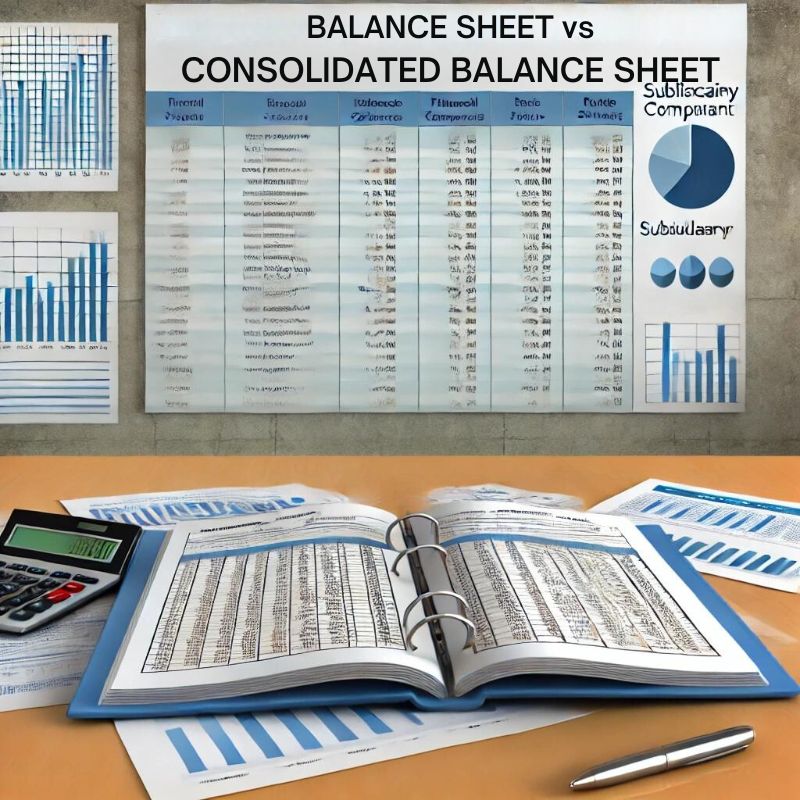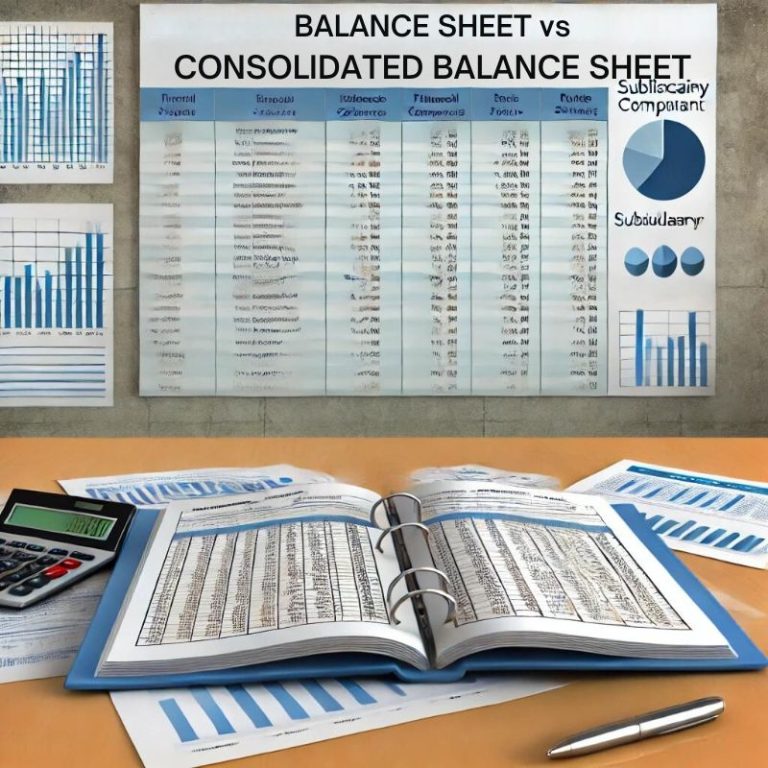A standalone balance sheet and a consolidated balance sheet are two main financial statements of corporate finance, revealing the financial condition of a company. Preparing these statements follows the standards of accounting and reflects the financial position of the company; however, the scope and usage of these statements are fairly different. A standalone balance sheet would talk about the financial aspect of one single entity, whereas a consolidated balance sheet talks about the combination of the financial statements of a parent firm and all the subsidiaries.
Therefore, the scope and range of information that appears in it mark the difference between a standalone balance sheet and a consolidated balance sheet. Standalone provides the financial status of an individual entity. This is essentially the micro-view of the assets, liabilities, and equity of a company. On the other hand, a consolidated balance sheet reflects the financials of a group of companies, including the parent and its subsidiaries, giving a holistic view of the entire business. It helps investors, creditors, and regulatory authorities to view the individual performance and financial stability of both the company and the corporate group.
What is a Standalone Balance Sheet?
A standalone balance sheet is that one where a company’s assets, liabilities, and equity are presented in view, without considering any subsidiaries or other affiliated companies’ financials. It is meant to be prepared for individually reporting companies only, to reflect their health and performance without reference to the parent-subsidiary.
Key Features:
- Individual Entity Financial Statement: The standalone balance sheet gives a snapshot of the status of an individual entity concerning its assets, liabilities, and equity.
- Ease of presentation: Report only the assets and liabilities of that particular company, thus making it simple and easy to understand.
- Legal and Compliance Needs: Sometimes, the standalone balance sheet may be prepared by companies to meet regulatory requirements, especially if the entity functions independently.
Components of Standalone Balance Sheet
- Assets: Any assets the company owns that have some economic value are current or non-current and involve cash, accounts receivable, inventory, equipment, and property.
- Liabilities: Liabilities are the debts and obligations of a company. These liabilities can be broken down into short-term liabilities, which include accounts payable and loans due within a year; and long-term liabilities, which include bonds and long-term loans.
- Equity: This is a residual interest in the assets of the firm after adjusting for liabilities. Share capital, retained earnings, and reserves are included in equity.
Example of a Standalone Balance Sheet
| Particulars | Amount |
|---|---|
| Assets | |
| Current Assets | 50,000 |
| Non-current Assets | 150,000 |
| Liabilities | |
| Current Liabilities | 40,000 |
| Non-current Liabilities | 100,000 |
| Equity | |
| Share Capital | 60,000 |
| Retained Earnings | 80,000 |
Advantages of Standalone Balance Sheet
- Simplicity: easier to prepare and analyze because it only concentrates on one company’s financials.
- Direct Insight: It gives a straightforward and crystal-clear view of the company’s financial condition, thereby helping make decisions for professionals who give importance to the individual company’s performance.
- Compliance: Of course, standalone financial statements are usually necessary for tax filings and regulatory reporting purposes.
Disadvantages of Standalone Balance Sheet
- Incomplete View: Not all of the company’s financial performance is represented. If a company maintains subsidiaries or other closely related businesses, it doesn’t represent the overall financial performance.
- Lack of Inter-company Transactions: This type of statement cannot account for the transactions between the parent company and subsidiaries. Hence, it provides a limited view of operations for any given company.
What is a Consolidated Balance Sheet?
A consolidated balance sheet is a statement combining two parents’ financial information of the parent company and all subsidiaries into one document, viewed as one entity group of companies. It is inevitable when a parent company has control over some subsidiaries. Normally, they hold voting shares above 50%.
Key Features
- Comprehensive Financial View: It gives a comprehensive view of the finances involved in a corporate group and how much can be made up of the parent company and its subsidiaries.
- Eliminates internal transactions: Internal transactions between the parent and its subsidiaries are shown to eliminate duplicate counting and what has to appear correctly on the balance sheet.
- Required for Group Reporting: A parent company having subsidiaries is mandatorily required to prepare consolidated financial statements to provide an integrated view of the group’s financial situation.
Components of Consolidated Balance Sheet
- Assets and Liabilities: A consolidated balance sheet combines the assets and liabilities of a parent company and its subsidiaries on one balance sheet to eliminate any duplication that results from intercompany transactions.
- Minority Interest: This is the portion of subsidiaries that is not owned by the parent company. It is reported separately under equity.
- Goodwill: Occurs when a parent firm purchases a subsidiary at a price greater than the fair market value of its net asset. Goodwill is an excess purchase price.
Example of a Consolidated Balance Sheet
| Particulars | Parent Company | Subsidiaries | Consolidated Amount |
|---|---|---|---|
| Assets | |||
| Current Assets | 100,000 | 50,000 | 150,000 |
| Non-current Assets | 300,000 | 100,000 | 400,000 |
| Liabilities | |||
| Current Liabilities | 80,000 | 20,000 | 100,000 |
| Non-current Liabilities | 120,000 | 60,000 | 180,000 |
| Minority Interest | – | – | 50,000 |
| Equity | |||
| Share Capital | 200,000 | 100,000 | 300,000 |

Advantages of Consolidated Balance Sheet
- Comprehensive Financial View: It provides an overall view of the parent company’s financial performance and subsidiaries.
- Eliminates Repetition: intercompany transactions are zeroed out. Incomes or expenditures have not been counted twice. Hence, a correct financial overview is achieved.
- Compliance with Accounting Standards: This is necessary to comply with legal and regulatory provisions related to group reporting.
Disadvantages of Consolidated Balance Sheet
- Complexity: It’s also more complex to prepare because you have to consolidate the financials of many statements which have intercompany, as well as minority interests.
- Mask Poor Performance: Poor performance at a subsidiary can be masked by the parent company in a set of consolidated financials. This makes it even more difficult for one to gauge the health of individual entities.
- Reduced Level of Disclosure for Subsidiary Performance: Investors seeking information about a particular subsidiary would not get this through a consolidated balance sheet that will not indicate any separate financials per entity.
Difference Between Standalone Balance Sheet and Consolidated Balance Sheet
| Criteria | Standalone Balance Sheet | Consolidated Balance Sheet |
|---|---|---|
| Scope | Includes only the financials of the individual company. | Combines the financials of the parent company and its subsidiaries. |
| Intercompany Transactions | Not relevant since the scope is limited to a single entity. | Eliminated to avoid double-counting of internal transfers. |
| Preparation Complexity | Relatively simple and straightforward. | More complex due to the need to consolidate multiple entities. |
| Legal Requirement | Typically required for standalone companies. | Legally required for companies that own subsidiaries. |
| Minority Interest | Not applicable. | Accounts for minority interest in subsidiaries. |
| Goodwill | Not applicable. | Includes goodwill arising from the acquisition of subsidiaries. |
Similarities in Standalone Balance Sheet and Consolidated Balance Sheet
While there are significant differences, both types of balance sheets share several similarities:
- Basic Format: Both have the same structure, in that they list assets, liabilities, and equity.
- Accounting Standards: Both follow the same accounting standards, such as IFRS or GAAP.
- Financial Position: Both give a snapshot of the financial position at any point in time; one is for a single entity, while the other is for a group.
- Usage: Both are required for financial analysis, investment decisions, and regulatory reporting.
Conclusion
General contributions to financial reporting, both the standalone balance sheet and the consolidated balance sheet, are important. A standalone balance sheet would ideally be useful for establishing the financial health of a single entity. A consolidated balance sheet does so; it presents the collective financials of the parent company and the subsidiary companies. Both are indispensable for stakeholders such as investors, creditors, and regulators for making analyses regarding the financial condition and performance of reporting entities.
Balance Sheet vs Consolidated Balance Sheet FAQs
What is the purpose of a standalone balance sheet?
A standalone balance sheet is used to assess the financial position of a single entity without considering its subsidiaries or related companies.
When is a consolidated balance sheet required?
A consolidated balance sheet is required when a parent company controls one or more subsidiaries, typically owning more than 50% of their voting rights.
Why are inter-company transactions eliminated in a consolidated balance sheet?
Inter-company transactions are eliminated to avoid double-counting of revenues, expenses, and other financial activities that occur between the parent and its subsidiaries.
What is minority interest in a consolidated balance sheet?
Minority interest refers to the portion of a subsidiary not owned by the parent company, and it is recorded separately in the consolidated balance sheet under equity.
Can a company have both a standalone and consolidated balance sheet?
Yes, a company can prepare both types of balance sheets, depending on the legal and regulatory requirements. The standalone balance sheet provides details about the parent company, while the consolidated balance sheet covers the entire corporate group.


